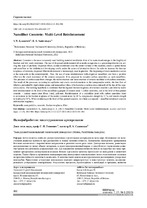| dc.contributor.author | Leonovich, S. N. | |
| dc.contributor.author | Sadovskaya, E. A. | |
| dc.coverage.spatial | Минск | ru |
| dc.date.accessioned | 2022-11-11T10:56:34Z | |
| dc.date.available | 2022-11-11T10:56:34Z | |
| dc.date.issued | 2022 | |
| dc.identifier.citation | Leonovich, S. N. Nanofiber Concrete: Multi-Level Reinforcement = Нанофибробетон: многоуровневое армирование / S. N. Leonovich, E. А. Sadovskaya // Наука и техника. – 2022. – № 5. – С. 392-396. | ru |
| dc.identifier.uri | https://rep.bntu.by/handle/data/122352 | |
| dc.description.abstract | Concrete is the most commonly used building material worldwide. One of its main disadvantages is the fragility of fracture and low crack resistance. The use of dispersed reinforcement of concrete composites is a promising direction in solving this type of problem. Dispersed fibers, evenly distributed over the entire volume of the material, create a spatial frame and contribute to the inhibition of developing cracks under the action of destructive forces. In order to increase the fracture toughness of concrete, dispersed fiber reinforcement is increasingly used in practice. The beginning of crack nucleation occurs at the nanoscale in the cement matrix. Thus, the use of nano-reinforcement with dispersed nanofibers can have a positive effect on the crack resistance of the cement composite. It is proposed to consider carbon nanotubes as such nanofibers. The presence of carbon nanofibers changes the microstructure and nanostructure of cement modified with carbon nanotubes. The result of the processes occurring in capillaries and cracks are deformations in the intergranular matrix, the free flow of which is prevented by rigid clinker grains and nanocarbon tubes, which creates a certain stress intensity at the tips of the separation cracks. The working hypothesis is confirmed that the required fracture toughness of structural concrete is provided by multilevel reinforcement: at the level of the crystalline aggregate of cement stone – carbon nanotubes, and at the level of fine-grained concrete – various macro-sized fibers (steel, polymer). Reinforcement of a crystalline joint with carbon nanotubes leads to an increase in the fracture toughness of the matrix (cement stone) by 20 %, compressive strength by 12 %, and tensile strength in bending by 20 %. When reinforcing at the level of fine-grained concrete, we obtain a composite – nanofibre-reinforced concrete with fracture toughness. | ru |
| dc.language.iso | en | ru |
| dc.publisher | БНТУ | ru |
| dc.title | Nanofiber Concrete: Multi-Level Reinforcement | ru |
| dc.title.alternative | Нанофибробетон: многоуровневое армирование | ru |
| dc.type | Article | ru |
| dc.identifier.doi | 10.21122/2227-1031-2022-21-5-392-396 | |
| local.description.annotation | Бетон является наиболее распространенным строительным материалом во всем мире. Основными его недостатками являются хрупкость при растяжении и низкая трещиностойкость. Применение дисперсного армирования бетонных композитов – перспективное направление в решении такого рода задач. Дисперсные волокна, равномерно распределенные по всему объему материала, создают пространственный каркас и способствуют торможению развития трещин под действием разрушающих сил. Для повышения трещиностойкости бетона на практике все чаще применяют армирование дисперсными волокнами. Начало зарождения трещины происходит на наноуровне в цементной матрице. Таким образом, применение наноармирования дисперсными нановолокнами может положительно сказаться на трещиностойкости цементного композита. В качестве таких нановолокон предлагается рассматривать углеродные нанотрубки. Присутствие углеродных нановолокон изменяет микроструктуру и наноструктуру цемента, модифицированного углеродными нанотрубками. Результатом процессов, происходящих в капиллярах и трещинах, являются деформации в межзерновой матрице, свободному течению которых препятствуют жесткие зерна клинкера и наноуглеродные трубки, что создает в вершинах разделительных трещин некоторую интенсивность напряжения. Подтверждена рабочая гипотеза, что требуемая трещиностойкость конструкционного бетона обеспечивается многоуровневым армированием: на уровне кристаллического заполнителя цементного камня – углеродными нанотрубками, на уровне мелкозернистого бетона – различными видами макроразмерной фибры (стальные, полимерные). Армирование углеродными нанотрубками кристаллического сростка приводит к повышению показателя вязкости разрушения матрицы (цементного камня) на 20 %, прочности на сжатие на 12 %, прочности на растяжение при изгибе на 20 %. При армировании на уровне мелкозернистого бетона получаем композит – нанофибробетон с вязкостью разрушения. | ru |

